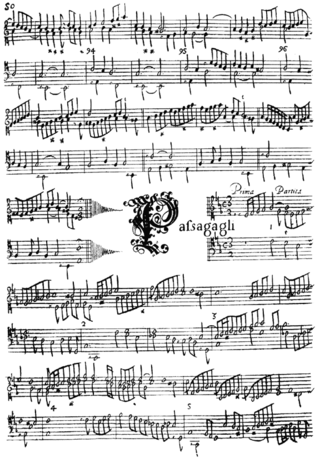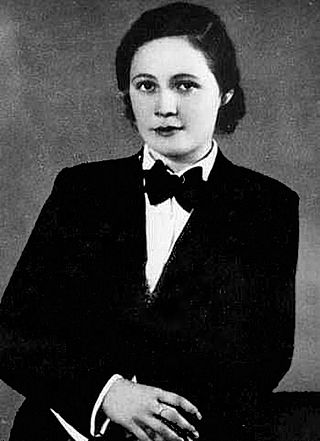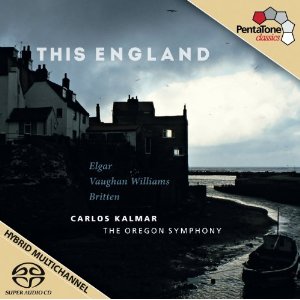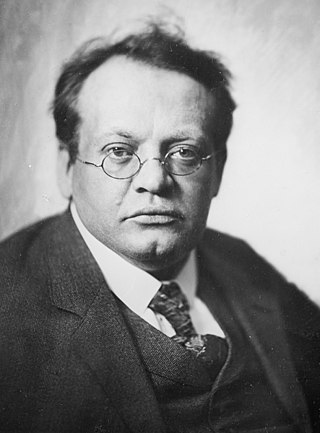
A chaconne is a type of musical composition often used as a vehicle for variation on a repeated short harmonic progression, often involving a fairly short repetitive bass-line which offers a compositional outline for variation, decoration, figuration and melodic invention. In this it closely resembles the passacaglia. It originates and was particularly popular in the Baroque era; a large number of Chaconnes exist from the 17th- and 18th- centuries.

The passacaglia is a musical form that originated in early seventeenth-century Spain and is still used today by composers. It is usually of a serious character and is often based on a bass-ostinato and written in triple metre.

Johan Halvorsen was a Norwegian composer, conductor and violinist.
In music, variation is a formal technique where material is repeated in an altered form. The changes may involve melody, rhythm, harmony, counterpoint, timbre, orchestration or any combination of these.
The Violin Concerto No. 1 in A minor, Op. 77, was originally composed by Dmitri Shostakovich in 1947–48. He was still working on the piece at the time of the Zhdanov Doctrine, and it could not be performed in the period following the composer's denunciation. In the time between the work's initial completion and the first performance, the composer, sometimes with the collaboration of its dedicatee, David Oistrakh, worked on several revisions. The concerto was finally premiered by the Leningrad Philharmonic under Yevgeny Mravinsky on 29 October 1955. It was well-received, Oistrakh remarking on the "depth of its artistic content" and describing the violin part as a "pithy 'Shakespearian' role."

Hilding Constantin Rosenberg was a Swedish composer and conductor. He is commonly regarded as the first Swedish modernist composer, and one of the most influential figures in 20th-century classical music in Sweden.

Jean Francisque-Étienne Martinon was a French conductor and composer.

Bernhard Sekles was a German composer, conductor, pianist and pedagogue.

Eugen Suchoň was one of the most important Slovak composers of the 20th century.

Miloslav Kabeláč was a prominent Czech composer and conductor. Miloslav Kabeláč belongs to the foremost Czech symphonists, whose work is sometimes compared with Antonín Dvořák's and Bohuslav Martinů's. In the communist period Kabeláč's work found itself on the periphery of official attention and was performed only sporadically and in a limited choice of compositions.

Vítězslava Kaprálová was a Czech composer and conductor of 20th-century classical music.

The pedal piano is a kind of piano that includes a pedalboard, enabling bass register notes to be played with the feet, as is standard on the organ.
The Symphony for Cello and Orchestra or Cello Symphony, Op. 68, was written in 1963 by the British composer Benjamin Britten. He dedicated the work to Mstislav Rostropovich, who gave the work its premiere in Moscow with the composer and the Moscow Philharmonic Orchestra on 12 March 1964. The work's title reflects the music's more even balance between soloist and orchestra than in the traditional concerto format.

Józef Koffler was a Polish composer, music teacher, musicologist and musical columnist.

Edvin Kallstenius was a Swedish composer and librarian. He arranged the traditional folk tune used as the de facto national anthem of Sweden, Du gamla, Du fria.
Alexander (Gustav) Adolfovich Winkler, also Alexandre Adolfovitch Winkler, was a Russian pianist, composer and music educator of German descent.

Le Laudi, Op. 25, is an oratorio by the Swiss composer Hermann Suter. The full title is Le Laudi di San Francesco d'Assisi . The text is Francis of Assisi's Canticle of the Sun in the original Italian. Suter scored the work for soloists, choir, children's choir, organ and large orchestra. It was premiered in 1924, with the composer conducting the Basler Gesangverein on the occasion of its centenary. The oratorio of around 70 minutes is one of Suter's most important works and has been championed by conductors such as Wilhelm Furtwängler, who conducted the first performance in Vienna in 1926 and further performances in Europe. Although now performed relatively rarely elsewhere, it has been presented regularly in Switzerland. It was also recorded in 1991 and 2007.

This England is a classical music album by the Oregon Symphony under the artistic direction of Carlos Kalmar, released by Dutch record label PentaTone Classics in November 2012. The album was recorded at the Arlene Schnitzer Concert Hall in Portland, Oregon, at five performances in February and May 2012. It contains works by three English 20th-century composers: Edward Elgar's Cockaigne , Ralph Vaughan Williams' Symphony No. 5, and "Four Sea Interludes" and "Passacaglia" from Benjamin Britten's opera Peter Grimes. The recording was the orchestra's second under Kalmar's leadership, following Music for a Time of War (2011), which also included works by Britten and Vaughan Williams. This England received positive critical reception but failed to chart.
Kurt George Roger was an Austrian–American composer.

Introduction, Passacaglia and Fugue in E minor, Op. 127, is an extended composition for organ by Max Reger, composed in 1913 and dedicated to Karl Straube who played the premiere in Breslau on 24 September. It was published in November that year in Berlin by Bote & Bock.













